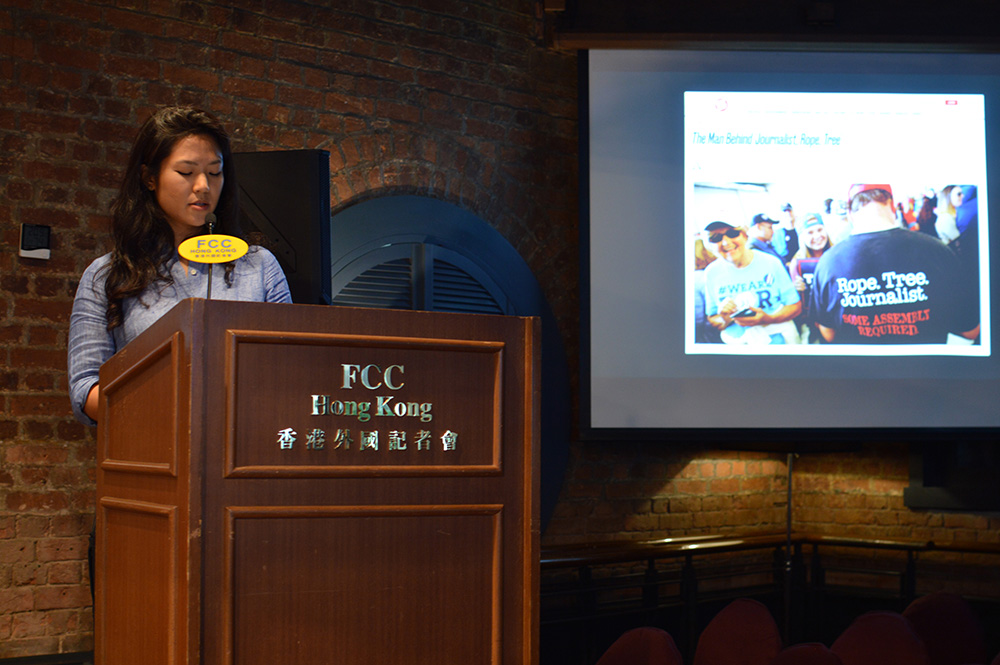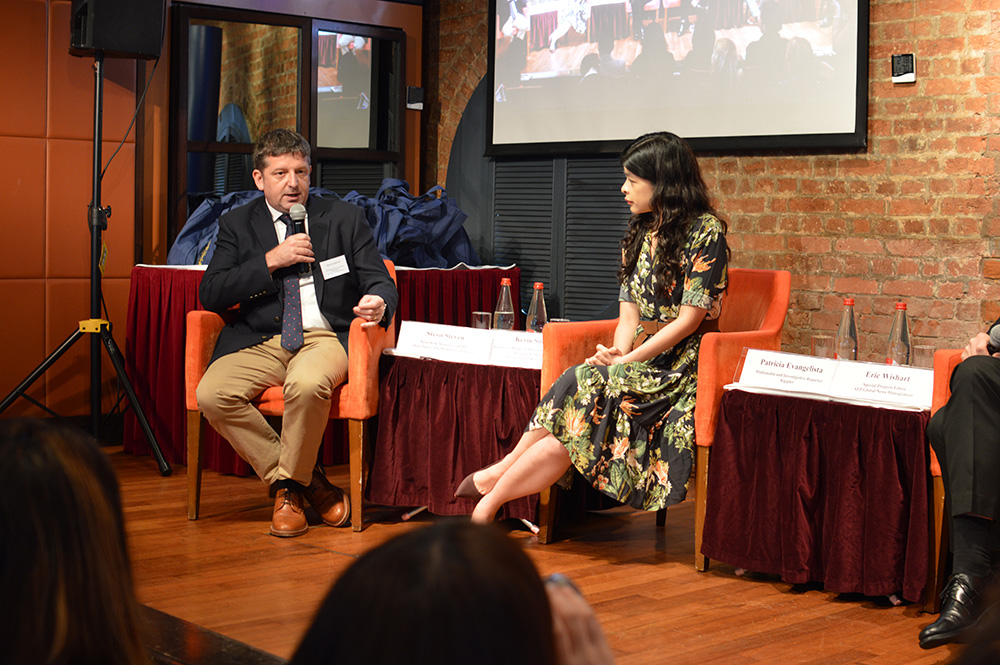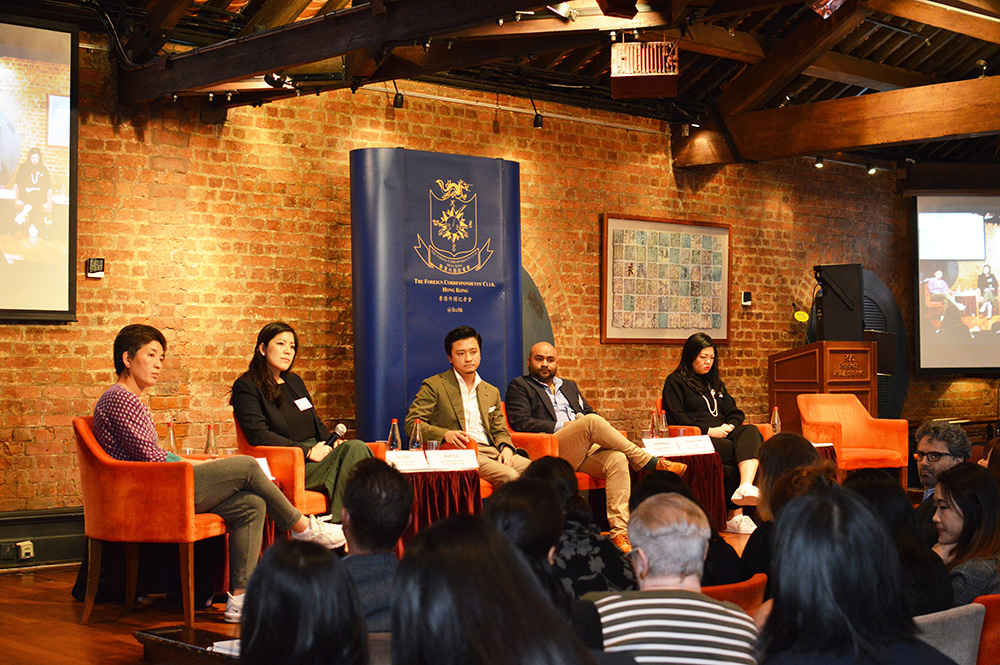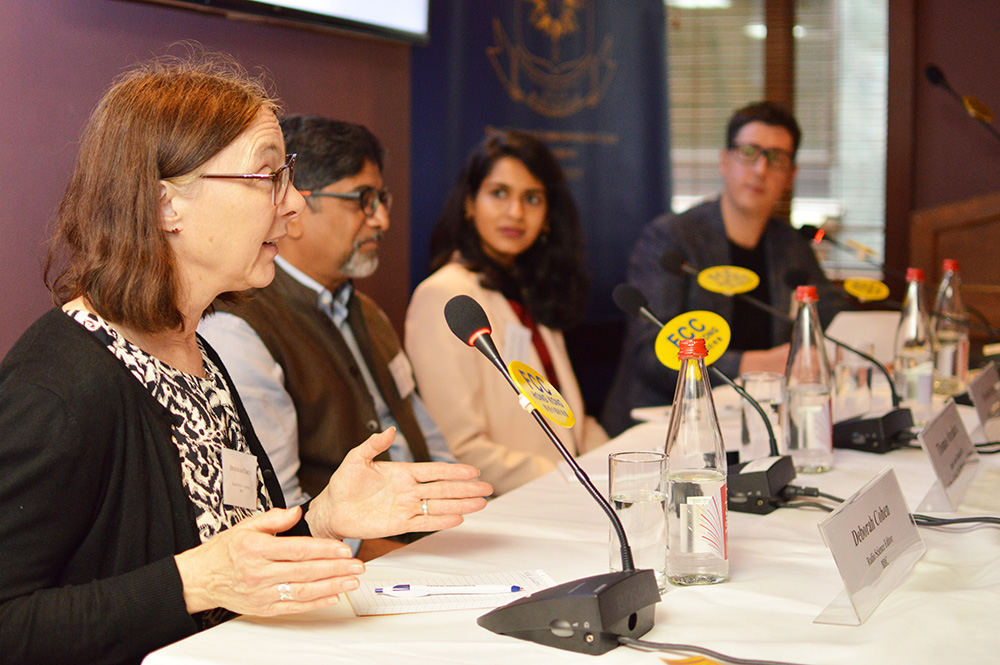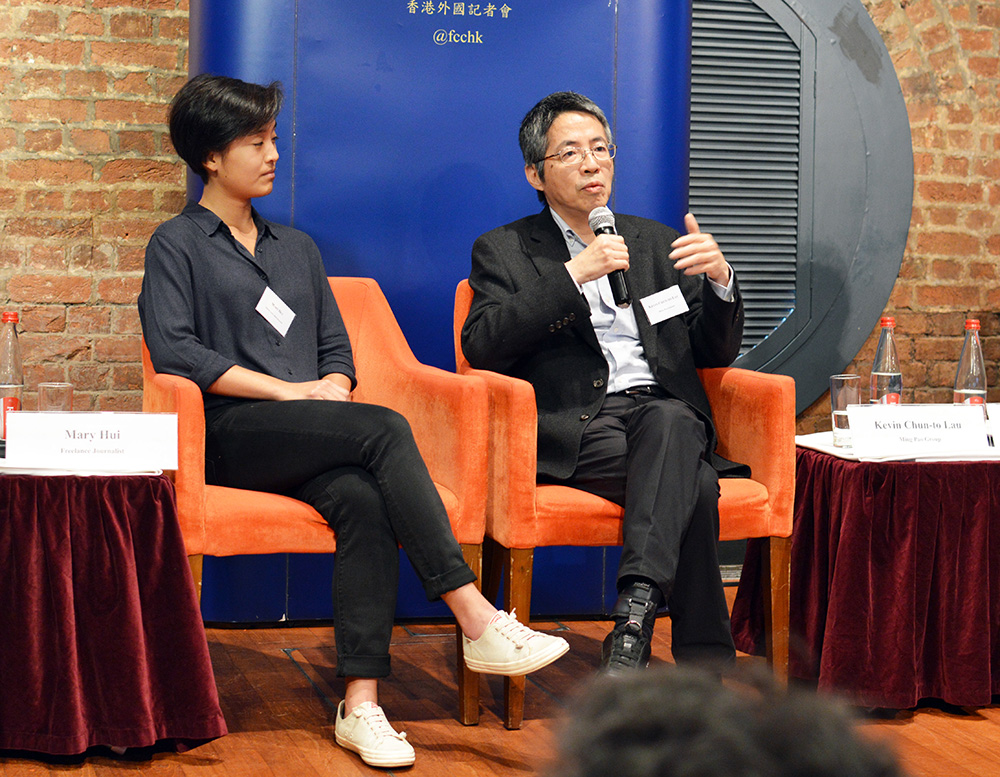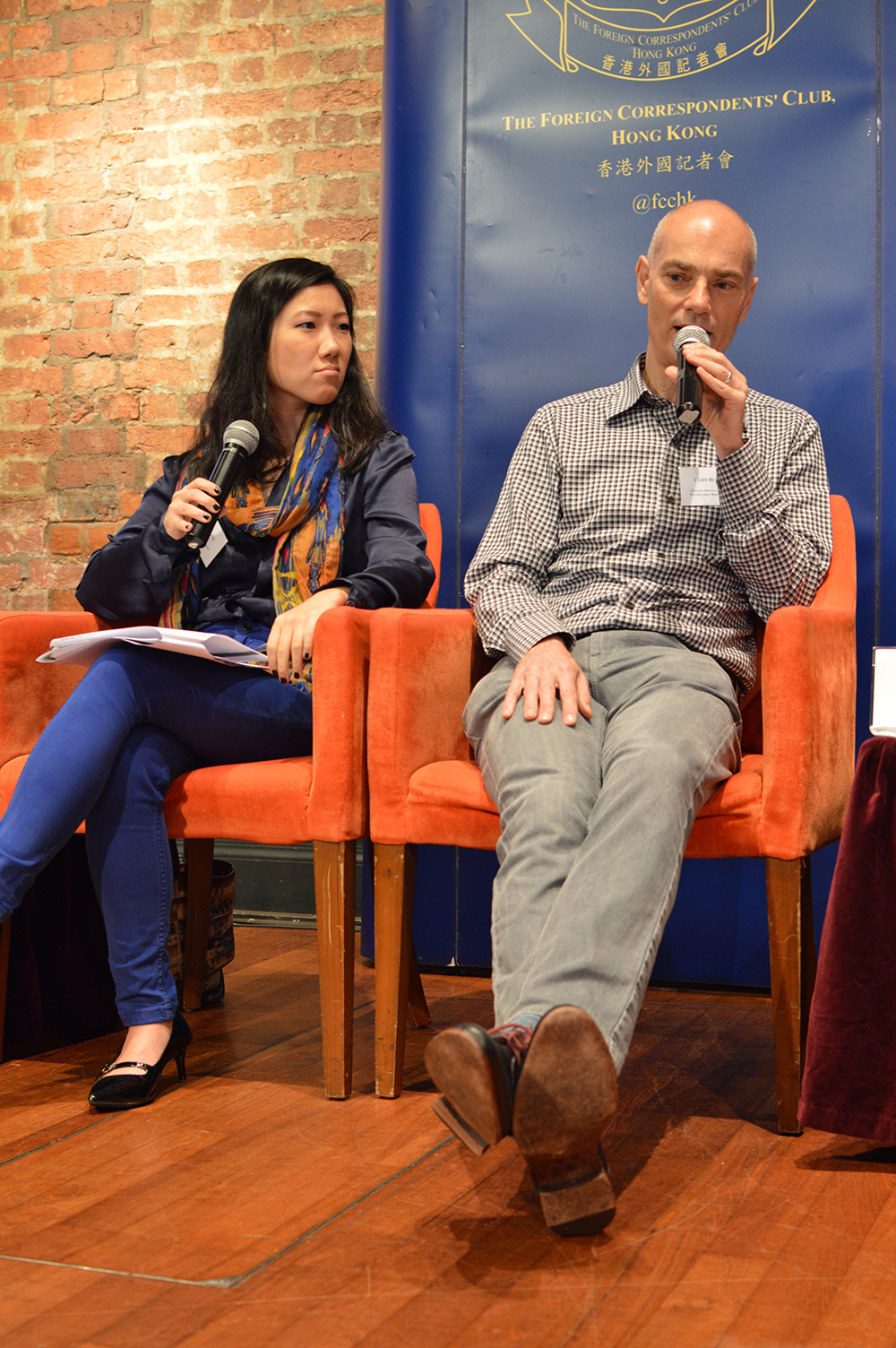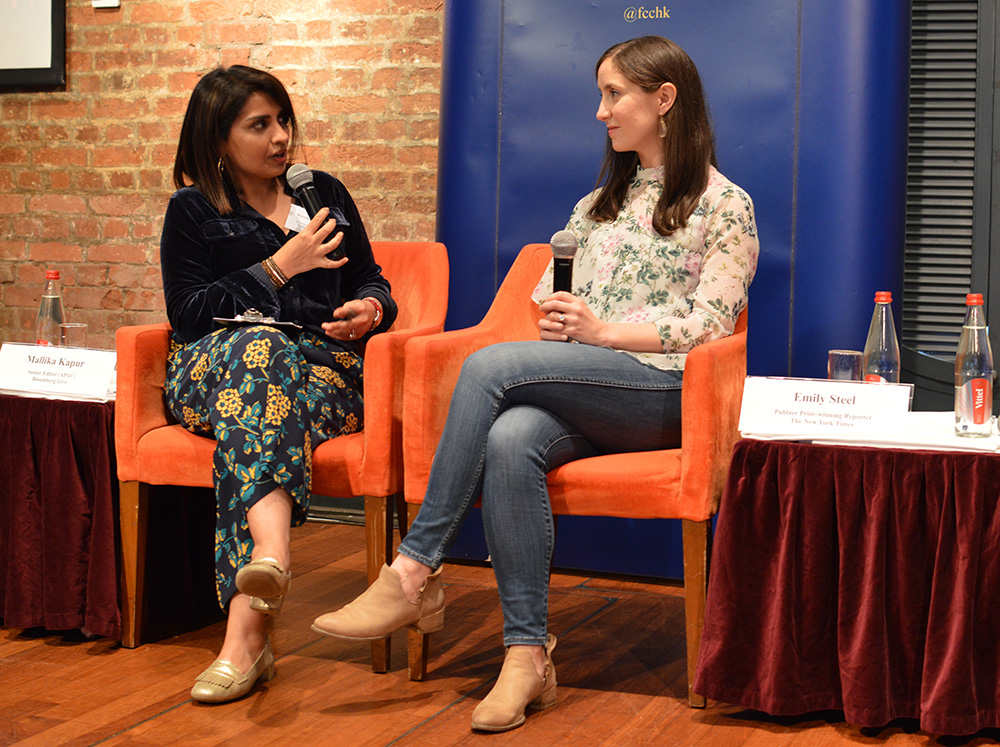
Enemies of the People? FCC Journalism Conference explores how industry is regarded
This year’s journalism conference brought together editors and correspondents from around the region under the title Enemy of the People? The Dangers of Being a Journalist in 2019. Eleven panels and workshops looked into this and other topics, under the guidance of conference convenor Enda Curran and his team.
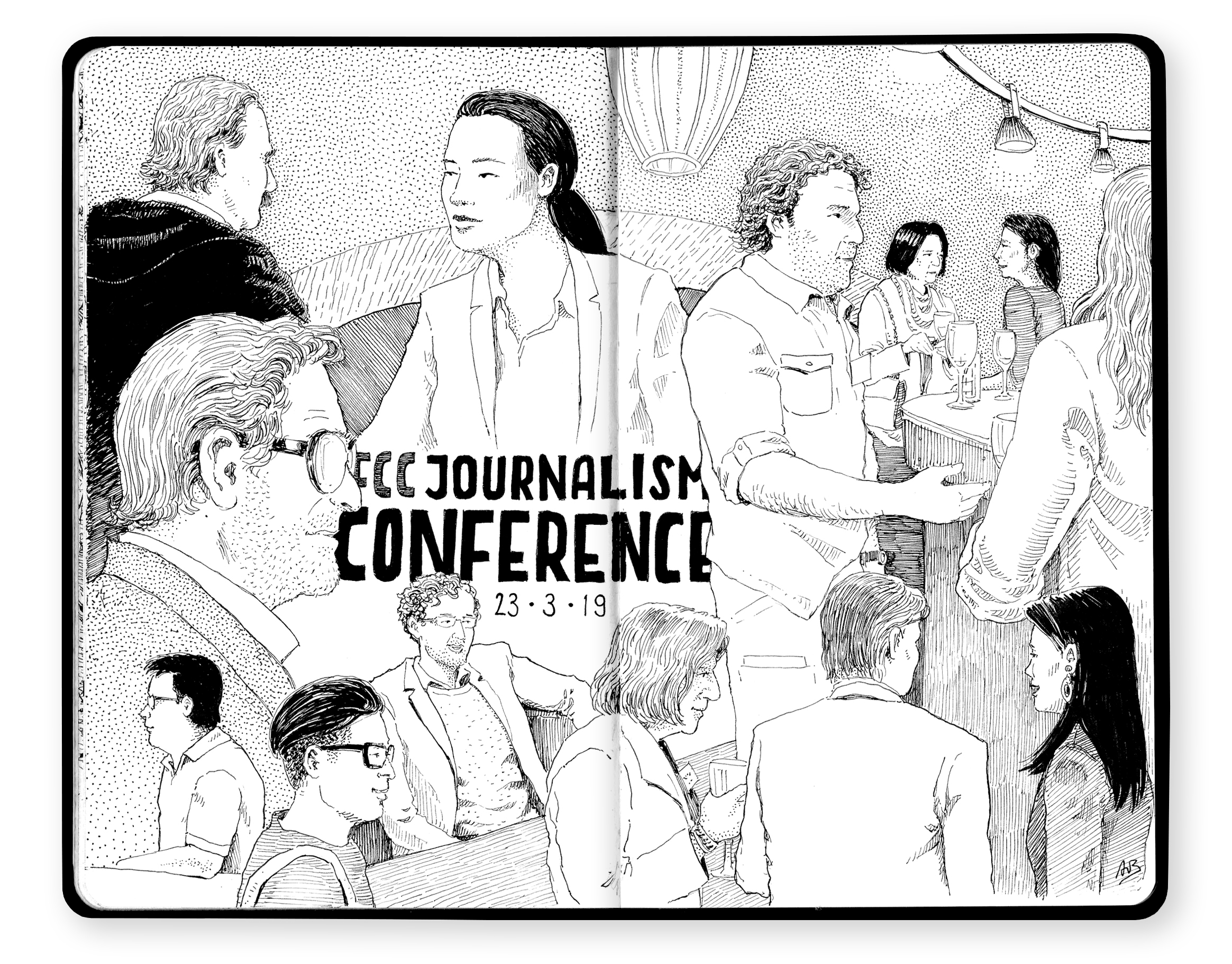 Speakers included conflict zone photographer Nicole Tung and Emily Steel, who kicked off the #MeToo movement with her reporting of sexual harassment for The New York Times.
Speakers included conflict zone photographer Nicole Tung and Emily Steel, who kicked off the #MeToo movement with her reporting of sexual harassment for The New York Times.
Online threats and security tips, press freedom in Hong Kong, and dangers for journalists in Asia all sparked lively Q&As, alongside workshops on how to get paid what you’re worth and how to use your phone to capture news footage, among others.
FCC President Florence de Changy announced the launch of the Clare Hollingworth Fellowship, named after the late journalist and long-time FCC member, offering free Club membership and mentoring for young journalists or those training to become journalists.
Reporting Team: Sue Brattle, Christy Choi, Morgan M. Davis, Jenni Marsh
Photographs: Sarah Graham/FCC
Sketches: Andreas von Buddenbrook
Keynote Address: Insights From a Conflict Zone Photographer
Hong Kong-born war photographer Nicole Tung kicked off the conference with a powerful reflection on the challenges facing journalists in conflict zones in 2019.
In Syria, the biggest threat was not the bombs, she revealed. It’s the paranoia of being kidnapped: the constant feeling that someone could be surveilling you.
Tung graduated from international school in Hong Kong with a desire to travel. That urge and her camera took her to the Arab Springs of Egypt then Libya, which she said were a “baptism of fire.” She then wound up in Syria with American journalist James Foley, who was later kidnapped and beheaded by ISIS. She said winning the 2018 James Foley Award for Conflict Reporting, named after her friend, made her feel “proud to continue the work he and others did.”
However, Tung said that her experience at the frontline had taught her that “no story is worth your life” – and that the perception of journalists in war zones has changed.
“In the 80s and 90s it was different,” she said. There was an understanding that journalists were meant to be “neutral mouthpieces”. Now, journalists are targets who authoritarian governments want to stop spreading information.
As a result, Tung said it was increasingly important to make sure our digital devices are clean – and that foreign journalists protect local reporters and fixers. When asked what her next project would be, Tung joked: “That’s a question that freelancers never have the answer to.”
Jenni Marsh
Opening Panel – Press Freedom and Dangers for Journalists in Asia
For Patricia Evangelista war is personal. That’s because the war she’s covering is the one in her home country: Philippines President Rodrigo Duterte’s war on drugs, during which so far 27,000 people have died.
As Rappler, the news outlet Evangelista works for, documents the destruction waged by Duterte – who campaigned on the promise he would kill 100,000 criminals – it has become public enemy number one. “I live where I work. It’s hard,” said Evangelista. “Everyone who speaks to me is at risk of being killed the next day.”
CNN’s Will Ripley has become the network’s de facto North Korea correspondent. He described how on his first visit to the hermit kingdom he got a rare chance to interview three Americans being held there.
Ripley admitted he was so nervous for his own safety during the interview that he “didn’t have as much compassion as I needed to have” for the prisoners. Having since been detained for 36 hours in a North Korean jail “for one innocent iPhone photo”, Ripley is keenly aware of the dangers.
Meanwhile, American journalist Kevin Sites shared his experience about travelling to every war in the world in one year for Yahoo! News to show “the human effect of war” – an objective that came up throughout the conference. And risk manager for Dow Jones Stevo Stephen stressed the importance of keeping journalists – whether freelance or staff – safe in conflict zones through panic buttons on mobile phones, by getting the right visas, and paying for hostile training courses.
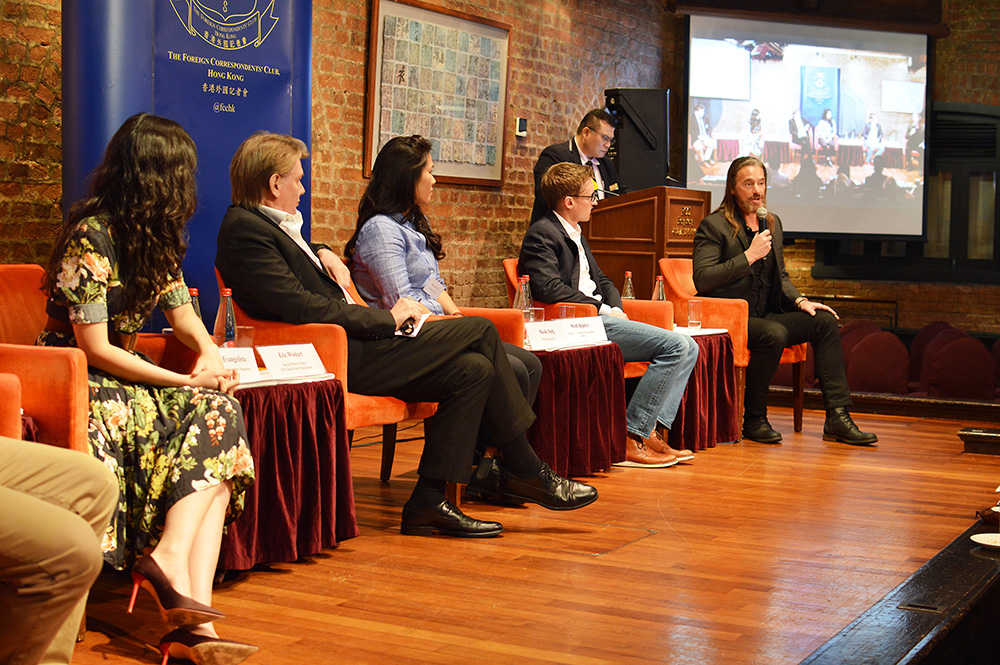 L-R: Stevo Stephen, Patricia Evangelista, Eric Wishart, Nicole Tung, Will Ripley and Kevin Sites. Photo: Sarah Graham/FCC
L-R: Stevo Stephen, Patricia Evangelista, Eric Wishart, Nicole Tung, Will Ripley and Kevin Sites. Photo: Sarah Graham/FCCThere was a question at the end of the talk that set the room a-twittering. “Women are more emotional,” a female attendee said, asking Tung: “How do you cope with being a woman in war?” The audience laughed.
But from this not-so-well phrased question came responses that captured the perhaps unintended theme of this panel: The role emotion has to play in news coverage.
Evangelista put it most poignantly: “The moment we look at a dead body and say that’s no. 2, that’s no. 3, that’s no. 4, that’s the problem. Not that we’re male or female. I’m human first, a reporter second. If I cannot feel… then I cannot expect the person reading or watching to care. I know we have to pretend to be fearless, but I am afraid every day.”
There was solidarity from the men on the panel. Sites joked that he and CNN’s Ripley were probably the most emotional people on the panel, and AFP’s Eric Wishart admitted he had to watch Nicole Tung’s introductory video 10 times before he could watch it without crying.
Sites also called for more solidarity within the profession. “One of the things journalists haven’t been very good about is standing up for each other.”
Christy Choi and Jenni Marsh
Cultural Journalism: How Best to Cover Asian Culture and Beyond, And Avoid the Pitfalls
Rule Number One for working in Asia, be able to speak three languages. They are the best tool for digging deep into stories and finding creative ways to tell them, a skill that is increasingly necessary in China if you want to keep your sources out of trouble. Hard-hitting advice from Amy Qin, China Correspondent of The New York Times, and her fellow panelists agreed that reporting on music, film, art, TV and theatre often involves touching on politics or economics.
“Visual art doesn’t attract huge audiences so you can slip under the radar,” said Enid Tsui, Senior Culture Writer at the SCMP.” But in the art world everyone has to speak English, a fact that mystifies Tsui. Kurt Lin, Senior Multimedia Producer for
SCMP’s Morning Studio, said: “I speak Mandarin, Cantonese and English so get to cover so many more stories because I can talk to local people. There is a need to employ more bi-lingual staff here.”
Another vital skill is being able to sell your story, said Vivienne Chow, founder of the Cultural Journalism Campus. “At the end of the day, the editor will ask: Who cares? We have to persuade people that culture matters. If you’re writing for a mainstream publication, you have to make your stories relevant to the general reader.”
Digital media means there are many more ways of reporting on culture, so this is “an exciting time for experimentation”, Tsui said. However, stories that end up going global, such as the #MeToo movement, don’t always spread rapidly. “You have to evaluate, is something important for your audience,” said Abid Rahman, International Digital Editor at The Hollywood Reporter. “The movement crippled Hollywood for months from October 2017, but it didn’t filter down to some other countries for some time.”
Sue Brattle
Workshop: Covering Health and Science Journalism
In 1988, The Lancet medical journal published a paper linking the MMR jab (measles, mumps, rubella) to instances of autism and the world went mad. Later found to be based on just 12 case studies and widely disputed, it still makes medical reporters shake in their boots. Deborah Cohen, BBC Radio Science Editor, said: “Whatever is published in reputable journals, we have to be very skeptical. The BBC got this wrong, as did many others.”
So, check who has funded a paper; Is there a vested interest in its findings? And stand back and wait to do your own fact-checking, don’t rush with the herd into publishing errors and half-truths. Cohen added: “We are translators of science for the public; we have to get it right.” Panelists suggested taking online courses to keep up-to-date, build an army of experts around you but be sceptical about what they tell you, and constantly read papers/journals etc being published.
Sometimes, when a science or health story becomes huge, it is taken away from specialist reporters and given to mainstream presenters and writers. That proves difficult for science specialists, as they don’t always want to share their sources but want to ensure the story is reported accurately.
Thomas Abraham, author of Polio: The Odyssey of Eradication, said: “Second-day stories are important. You can get as much new information as there was in Day One’s press release. Stay away from people who are trying to tell you something. Throw away all press releases. Everyone has got them. And nothing happens in isolation, there is always a context. It is the story that becomes an outrage, not the science, because that is how us humans react.”
Preetika Rana, Asia Corporate Reporter, The Wall Street Journal, said: “If the story is already out, you need to put accuracy before speed.”
Sue Brattle
Workshop: Mobile Video Storytelling Tools & Techniques to Produce High Quality Content
This workshop was packed with advice – and the realisation dawned that taking selfies is just about the best training you could have given yourself for filming news video footage on your phone. Aleksander Solum, Senior Video Journalist at Reuters Video News, said: “Most people watch news as much on their phone as on their TV so we are learning how we can use our phones for breaking news.” Reuters filmed the 2018 rescue of a junior football team from a Thai cave on mobile phones for 4/5 hours before other equipment arrived, Solum said.
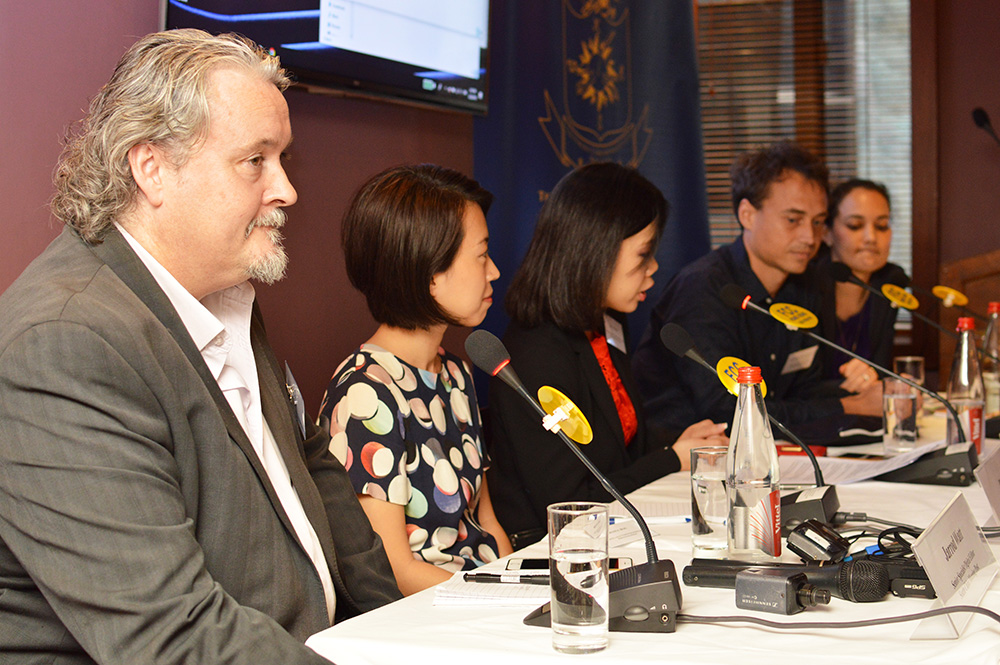 L-R: Jarrod Watt, Diana Jou, Zela Chin, Aleksander Solum and Lisa Yuriko Thomas. Photo: Sarah Graham/FCC
L-R: Jarrod Watt, Diana Jou, Zela Chin, Aleksander Solum and Lisa Yuriko Thomas. Photo: Sarah Graham/FCCHe added the kit you need to carry: A mobile phone, mobile wi-fi (stored in a waterproof bag), battery pack, microphone, gaffer tape and a selfie stick.
Diana Jou, freelance videographer and photographer, stressed the importance of planning your video shoot. “Before you shoot, ask what is your story? Explain it to yourself in one sentence. Is it visual? Is it worth taking? Lay down a structure on paper. Chose voiceover, or words on the screen. Write down the beginning, middle and end.”
The massacre at two mosques in Christchurch, New Zealand (eight days before the conference) which the shooter showed on Facebook Live before Facebook shut it down concerned Jarrod Watt, Senior Specialist Digital Editor at SCMP. He said: “It will be a debate I’ve been waiting three years for.”
Sue Brattle
Hong Kong Press Freedom – The Challenges Facing Local Journalists
Hong Kong’s press freedom gained global attention last year, after Financial Times journalist Victor Mallet was forced to leave the city. For local journalists, a contentious relationship with the Hong Kong government was nothing new.
“Among working journalists, there’s still a strong commitment for freedom of the press and freedom of expression,” said Chris Yeung, chairperson of the Hong Kong Journalists Association and chief writer at Citizen/News. But fears of government backlash have led to self-censorship by many local journalists over the years. “Reporters have to make sure their reports are not seen as political advocacy,” he said.
Mary Hui, a young freelance journalist, agreed that self-censorship is a harsh reality for many. After Mallet’s expulsion from Hong Kong, Hui was prepared to write something about press freedom in Hong Kong, but her friends and family talked her out of it, questioning if she wanted to draw such attention to herself so early in her career. For journalists like Kevin Lau Chun-to of Ming Pao Group, the cost of reporting in Hong Kong can be high. Lau suffered a brutal knife attack in 2014 that left him in hospital for months, and in physical therapy until just recently.
While such attacks on journalists in the city are rare, they are real enough to many parents that they will discourage their children from pursuing careers as journalists, said Lau, telling the story of a young girl who was torn about becoming a reporter. “When one student struggles for a whole year about whether or not to go into journalism, there are many more stories about giving up,” he said.
Yeung summed up the state of Hong Kong’s press freedom as “depressing”. “Unfortunately, we can’t see a major change in political weather in the foreseeable future,” he said.
Morgan M. Davis
How to Not Get Sued
At some point during their career, a journalist is likely to print something defamatory. With or without the backing of their publication they need to be prepared for a potential lawsuit. But as laws differ globally, understanding the basics of a suit and where the burden of truth lies can be complicated.
For Hong Kong, press laws are largely in line with the UK, something that can prove surprising to U.S. journalists. Where the U.S. can rely on explicit laws, such as the Freedom of Information Act, to aid reporters, Hong Kong exists in more of a grey area.
Unfortunately for defamation laws, the ambiguity can come at a price for journalists. “When it comes to defamation laws it’s not very friendly to journalists,” said Cliff Buddle, senior editor at South China Morning Post.
Buddle, in his unofficial role as SCMP’s legal eagle, regularly works with journalists and editors to assess the risk involved in printing certain information. While many reporters want to defend a story with “but it’s true”, defamation laws in Hong Kong put the burden of proof on the journalist, said Buddle. “Libel laws in Hong Kong favour the wealthy,” he said, adding that the risks for printing something defamatory are high.
The risk of legal action shouldn’t scare journalists away from a story, but they need to be responsible in their reporting, and be prepared to produce notes, recordings and other information should their reporting be brought into question. Hong Kong barrister Queenie Lau pointed out a handful of different defences a journalist can rely on in court, using facts and proving substantial truth to battle a lawsuit.
“It should be a question of ‘How do we get this in and make it as safe as possible?’” said Buddle of pre-publication discussions. “The question of balance is an important one.”
Morgan M. Davis
A Conversation With Emily Steel
The #MeToo movement has rocked the world in the last 18 months, putting a spotlight on sexual assault and harassment, and taking down powerful men in its wake. Behind the movement have been journalists, diligently reporting tales of harassment and the shocking numbers of allegations and lawsuits that have long been swept under the rug. Emily Steel, a Pulitzer Prize-winning reporter from The New York Times, shared her experiences reporting on U.S. television host Bill O’Reilly and the endemic harassment found at Fox News.
For Steel, the story started with former anchor Gretchen Carlson’s allegations of harassment against then Fox News chairman Roger Ailes. Carlson’s suit led to Steel and the NYT’s pursuit of other such stories, building on documents and data to share personal stories from women who faced similar problems at Fox.
For Steel, getting the personal stories from O’Reilly’s victims proved to be challenging. Those who had approached Fox and settled harassment claims had signed non-disclosure agreements, blocking Steel’s reporting. Steel and her teammate had to look for other possible victims, cold calling them, knocking on doors and sending handwritten letters. “The thing that’s amazing about all of this is how we’ve seen these behaviours repeating,” said Steel. The pattern of abuse ultimately led Steel to find other O’Reilly victims that had previously not come forward.
O’Reilly had personally threatened Steel in the past, who was ready for the possibility of a lawsuit after her story broke. “Fox News really had a history of attacking reporters who had written critically about Fox,” she said. But Steel’s story touched a nerve in the American people, leading to massive backlash and the firing of O’Reilly.
Steel admitted that she was so centred on the Fox story that for a while she didn’t see how large the #MeToo movement could become. “We were so focused on these details [at Fox], we didn’t know what the bigger picture would be,” she said. But “[Me Too] is something that unleashed in the U.S. and moved globally”.
Morgan M. Davis
How To Get More of What You’re Worth
“Money is power and a reflection of what you’re worth.” That was the bold opening remark from a lively panel that saw the FCC conference reach out across the divide to – say it quietly – non-journalists.
HR Relationship Manager at the Bank of America Merrill Lynch, Tonia Wong Kee, reminded women to never accept the first offer they get. There’s always more cash, she said – it’s up to us to research the market and know the value of a role.
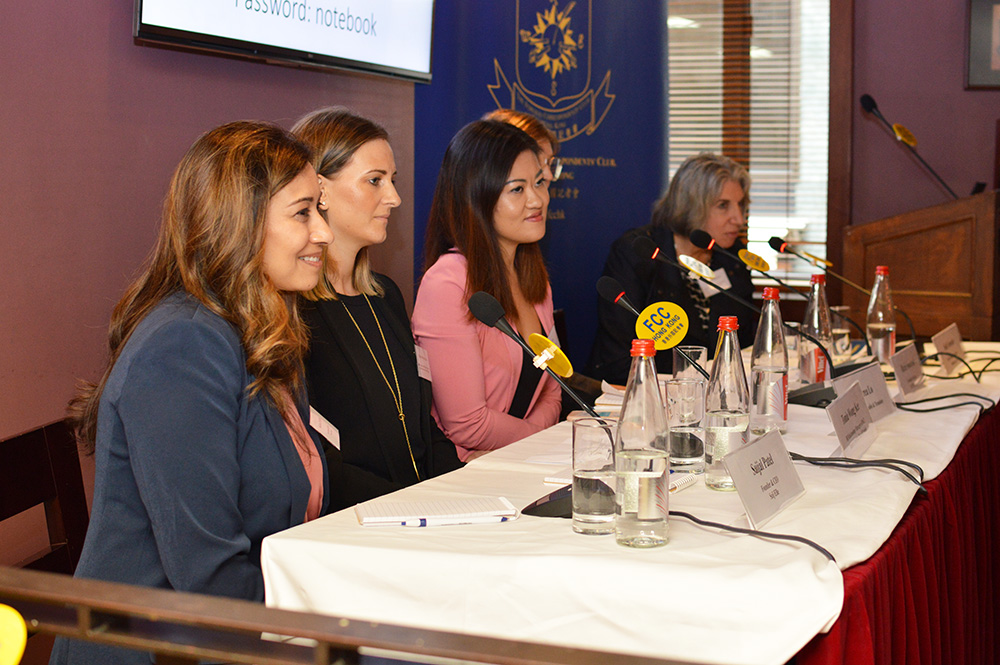 L-R: Saijal Patel, Tonia Wong Kee, Andrea Lo, Marie Swarbreck and Jodi Schneider. Photo: Sarah Graham/FCC
L-R: Saijal Patel, Tonia Wong Kee, Andrea Lo, Marie Swarbreck and Jodi Schneider. Photo: Sarah Graham/FCCMeanwhile, Saijal Patel, a former correspondent and founder of Saij Elle, made the excellent point that women are too focused on their experience matching the criteria for a new job, when they should be focusing on their vision for the role. “Women think about what they’re contributing. Men think about their potential,” she said. “People hire for potential.”
Seasoned bilingual freelancer Andrea Lo revealed that she keeps a spreadsheet of who owes her what and when – and isn’t afraid to take to Twitter to shame a severely late-paying client into coughing up the cash. Marie Swarbreck, founder of FLEXImums, was all about helping women get back into the workforce after taking a break to start a family.
The main takeaway from the event was that women should look again at how they assess their worth and options.
Jenni Marsh
Workshop: Online Security Tips & Tools Every Journalist Should Know; Closing Panel – Online Threats Journalists Face in 2019
Don’t open strange text messages. Use two-factor authentication for everything. Don’t use free hotel WiFi. Use encrypted apps. Check email URLs for any suspicious misspellings. If a link in an email opens up a page asking for logins, don’t enter anything – it’s likely a phishing attack. Train all your colleagues at a newsroom to do the same – even those who don’t think their work is sensitive enough to warrant being watched. And ultimately, get your organisation to get behind security and train people in the latest measures. These were the key takeaways of the workshop.
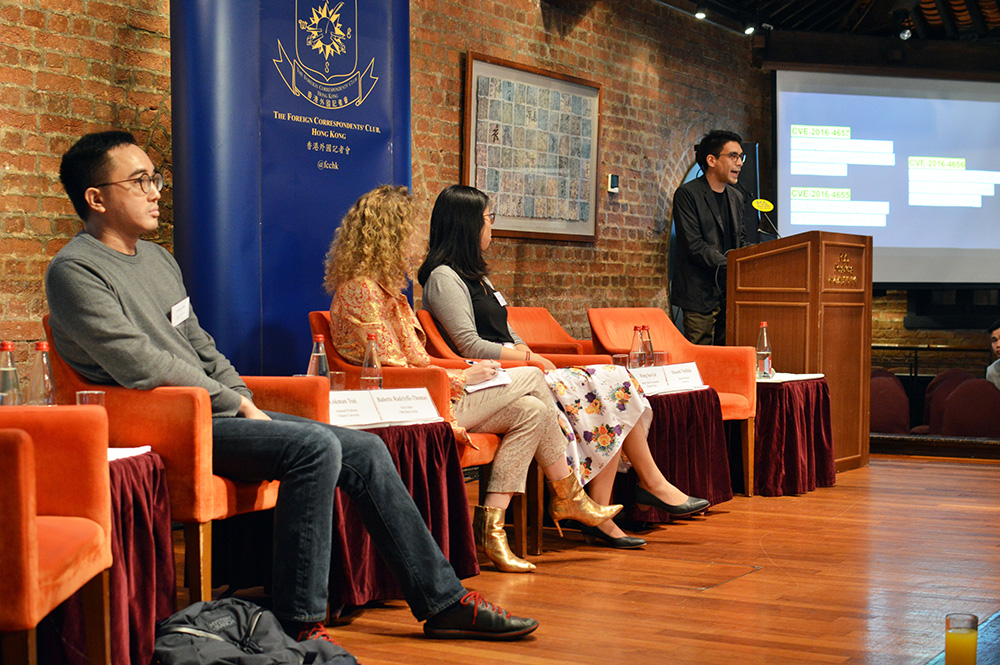 L-R: Lokman Tsui, Babette Radclyffe-Thomas, Sue-Lin Wong and Masashi Nishihata. Photo: Sarah Graham/FCC
L-R: Lokman Tsui, Babette Radclyffe-Thomas, Sue-Lin Wong and Masashi Nishihata. Photo: Sarah Graham/FCCBut even the best-laid security plans can go awry, as Sue-Lin Wong of the FT showed with her tale of chasing a story about workers who had developed lung diseases after being exposed to construction dust in Shenzhen. It was the workers themselves who accidentally let slip to the authorities in their excitement that someone was expressing interest in their story, and ultimately scuppered her reporting trip.
“As a journalist you can do all you can to prepare, but there are sometimes factors out of your control,” said Wong. Other than the threats journalists face from people who don’t want them to report, there’s now the additional threat of online harassment and threats that can transform into very real problems. It’s something that President Trump’s rhetoric inciting hatred against journalists is having an impact on and something that social media exacerbates.
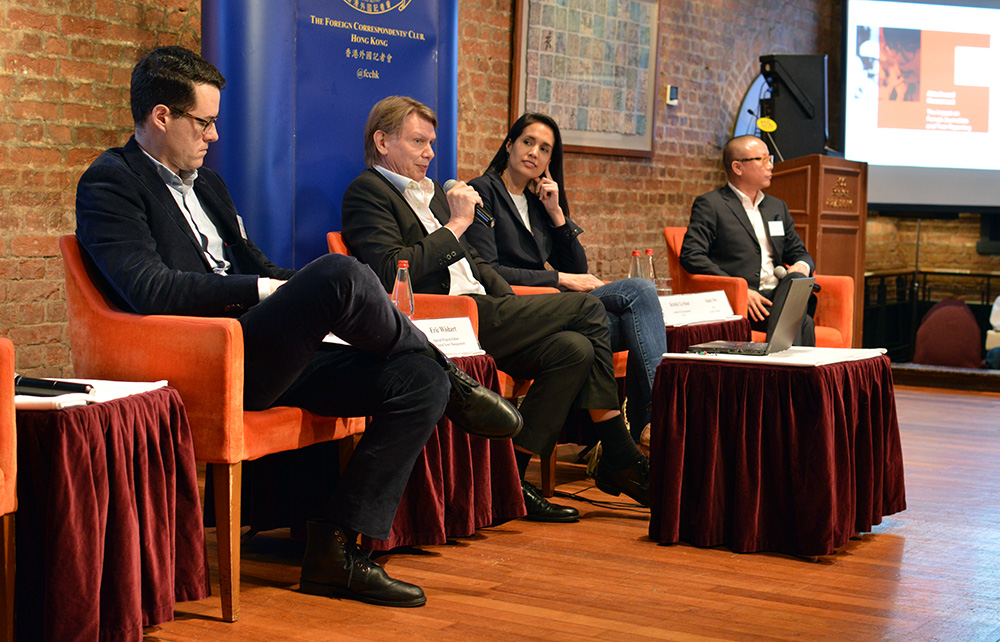 L-R: Tim McLaughlin, moderator Eric Wishart, Kristie Lu Stout, and Sonny Swe. Photo: Sarah Graham/FCC
L-R: Tim McLaughlin, moderator Eric Wishart, Kristie Lu Stout, and Sonny Swe. Photo: Sarah Graham/FCCThe audience heard from freelance journalist Rana Ayyub who, since 2010, has been sent death threats, rape threats and even had her face superimposed onto pornography. She spoke of being harassed over multiple social media platforms, having her phone number and address posted online, being hospitalised for anxiety, and the additional stress that comes of being a freelancer in this situation. “You become all the more vulnerable, because you have to fend for yourself,” Ayyub said via Skype.
Sonny Swe, founder of Frontier Myanmar who spent eight years in jail, and CNN’s Kristie Lu Stout spoke of the routine harassment and threats they face both on and off screen. Swe said: “My sister is trolled. I am careful, my doors and windows are locked.” Kirstie described how she checks for exits when she’s out on a job, and said: “It’s recognising and acknowledging there is a connection, that online abuse and online hatred can take root, fester and transform into something like real-world terrorism, like we saw happen in Christchurch. That is real.”
Christy Choi

